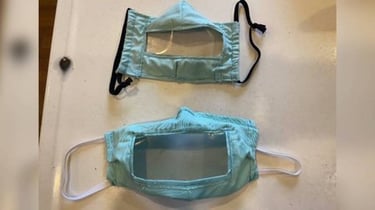 As COVID-19 continues to impact communities around the world, people are coming together to help one another now more than ever.
As COVID-19 continues to impact communities around the world, people are coming together to help one another now more than ever.
Ashley Lawrence, a 21-year-old in Kentucky, noticed that since so much of the population now are opting to wear protective face masks, those who are deaf or hard of hearing and rely on lip reading are struggling to access critical information.
So she and her mom set to work sewing masks using plastic fabric and bed sheets, experimenting with various attachments for people who use cochlear implants and hearing aids and can’t wrap mask straps around their ears.

On the DHH Mask Project GoFundMe page Lawrence said she would distribute the masks for free to those who request them so they can provide them to their Doctors if they need medical attention.
Lawrence also said they were no longer accepting donations as they had met their goal, saying she was “completely overwhelmed” by the response.
For anyone who wants a mask, she suggested emailing dhhmaskproject@gmail.com. However, she noted they are struggling to meet the high demand.
“I felt like there was a huge population that was being looked over,” Lawrence told local news station LEX18. “We’re all panicking right now and so a lot of people are just not being thought of. So I felt like it was very important that, even at a time like this, people need to have that communication.”
And for anyone who wants to make face masks for their own community, Ashley said she would post a YouTube tutorial soon and would be willing to email the sewing pattern upon request.
According to Huffington Post, the Deaf Society advocates for sign language interpreters to be present for any interactions between DHH people and medical personnel, but these face masks could add further dimension to these interactions by allowing clients to see medical staff’s facial expressions and read their lips.


 What Nurses Need to Know about COVID-19
What Nurses Need to Know about COVID-19 During this global health crisis, telehealth is an effective solution for the prevention and treatment of COVID-19.
During this global health crisis, telehealth is an effective solution for the prevention and treatment of COVID-19. 